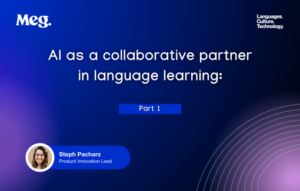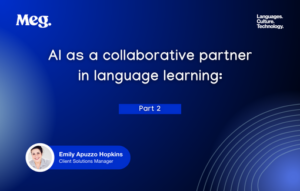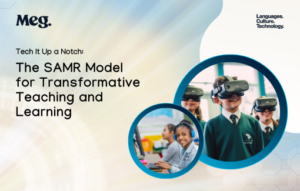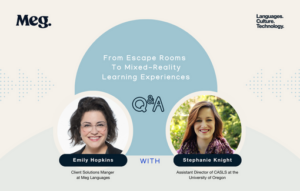Unlocking the Future of Education: Resources For Educators
AI is transforming classrooms and empowering both teachers and students alike. As we gear up for our upcoming LinkedIn chat, “AI for Global Ed,” we invite you to delve into a curated collection of blog posts and resources that spotlight the incredible impact of AI in education, and its intersection with other tools, like VR. Uncover the ways in which AI is reshaping the learning experience, and explore how VR enhances these advancements to create a truly immersive and engaging educational environment.
AI As A Collaborative Partner In Language Learning: Part 1
 Steph Pacharz’s blog post explores AI as a collaborative partner in language learning, emphasizing its role in efficient lesson planning and boosting teacher creativity. The post provides a practical example of using ChatGPT for standards-based lesson planning in a Spanish World Languages class. She advocates for viewing AI as a supportive tool, not a replacement for teacher expertise, ensuring a balanced language learning experience. Read the full blog post here.
Steph Pacharz’s blog post explores AI as a collaborative partner in language learning, emphasizing its role in efficient lesson planning and boosting teacher creativity. The post provides a practical example of using ChatGPT for standards-based lesson planning in a Spanish World Languages class. She advocates for viewing AI as a supportive tool, not a replacement for teacher expertise, ensuring a balanced language learning experience. Read the full blog post here.
AI As A Collaborative Partner In Language Learning: Part 2
 In Emily Apuzzo Hopkins’ blog post, she shares her experiential journey using AI as a language learning tool. As a former teacher, she initially approached AI from a teacher’s perspective, focusing on standards and lesson planning. However, she discovered the effectiveness of putting on her student hat, interacting with AI platforms like ChatGPT and HyperGlot, and embracing trial and error for a more authentic learning experience. Read the full blog post here.
In Emily Apuzzo Hopkins’ blog post, she shares her experiential journey using AI as a language learning tool. As a former teacher, she initially approached AI from a teacher’s perspective, focusing on standards and lesson planning. However, she discovered the effectiveness of putting on her student hat, interacting with AI platforms like ChatGPT and HyperGlot, and embracing trial and error for a more authentic learning experience. Read the full blog post here.
Tech It Up A Notch: The SAMR Model For Transformative Teaching And Learning
 In Emily Apuzzo Hopkins’ blog post, she discusses the SAMR Model (Substitution, Augmentation, Modification, Redefinition) as a transformative tool for teachers to monitor and enhance technology integration in the classroom. Emily shares her personal journey with SAMR, enlisting the help of ChatGPT to break down SAMR into easily digestible concepts and providing practical examples for each level, emphasizing its role as a ladder for teachers to explore technology integration effectively. Read the full blog post here.
In Emily Apuzzo Hopkins’ blog post, she discusses the SAMR Model (Substitution, Augmentation, Modification, Redefinition) as a transformative tool for teachers to monitor and enhance technology integration in the classroom. Emily shares her personal journey with SAMR, enlisting the help of ChatGPT to break down SAMR into easily digestible concepts and providing practical examples for each level, emphasizing its role as a ladder for teachers to explore technology integration effectively. Read the full blog post here.
From Escape Rooms To Mixed-Reality Learning Experiences: A Q&A With Stephanie Knight
 In Emily Apuzzo Hopkins’ Q&A with Stephanie Knight, Assistant Director of CASLS, they explore Stephanie’s role in designing mixed-reality language learning experiences. Stephanie discusses her projects, such as Virtual and Augmented Reality for Language Training (VAuLT), which transforms escape room mechanics into language learning contexts. She emphasizes the importance of celebrating productive frustration, protecting underspecification in learning experiences, and highlights the impact of digital tools on language learning accessibility and competencies. Read the full blog post here.
In Emily Apuzzo Hopkins’ Q&A with Stephanie Knight, Assistant Director of CASLS, they explore Stephanie’s role in designing mixed-reality language learning experiences. Stephanie discusses her projects, such as Virtual and Augmented Reality for Language Training (VAuLT), which transforms escape room mechanics into language learning contexts. She emphasizes the importance of celebrating productive frustration, protecting underspecification in learning experiences, and highlights the impact of digital tools on language learning accessibility and competencies. Read the full blog post here.
Share this post

